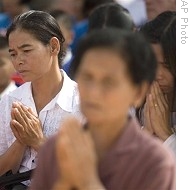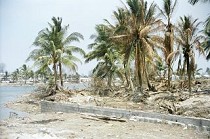voa标准英语2008-Tsunami Victims Recovering 4 Years After Disaste(在线收听)
 |
| Thais and others offer prayers during remembrance services at Dolphin Park on Patong Beach in Phuket, Thailand, 26 Dec 2008 |
Nearly one quarter of one million people were killed by the tsunami. Entire communities were wiped out, houses destroyed, lives ruined.
Now, four years after this catastrophic event, the Red Cross reports 97 percent of houses planned for people affected by the tsunami are finished or under construction. And, hundreds of new hospitals, clinics and schools have been built back better.
The International Federation's special representative for tsunami recovery, Jerry Talbot, tells VOA the lives of people who lost everything also have been rebuilt and are improving.
"And, building back better is making sure that these families are able to function again, have somewhere to live, that they have livelihoods and that they are members of communities that are more resilient and safer," said Talbot.
 |
| Baan Nam Khem, Khao Lak Phang Nga Province, Southern Thailand - hardest hit from Dec 26 tsunami (VOA photo - R. Corben) |
Talbot acknowledges that some people have been so deeply traumatized by the disaster that the scar will stay with them for the rest of their lives. He says many people, who have lost loved ones, will need special care.
"Every one of those persons who died, of course, leaves behind a grieving family. And, very often, of course, it means that we have a lot of single parent households, for example where people are struggling to take care of a young family whilst at the same time trying to find the wherewithal to make sure that there is something in the kitchen every day," he said.
Talbot says tsunami-affected communities run many risks from climate change, flooding, landslides and other disasters. He says these disasters cannot be prevented, but people can and are being taught how to mitigate future risks.
He says early warning systems have been set up to alert people to approaching danger.
So far, more than four million people have received assistance from the Red Cross. The agency says it expects to complete all work by the end of 2010. By then, the Red Cross says it will have spent more than $2.5 billion.